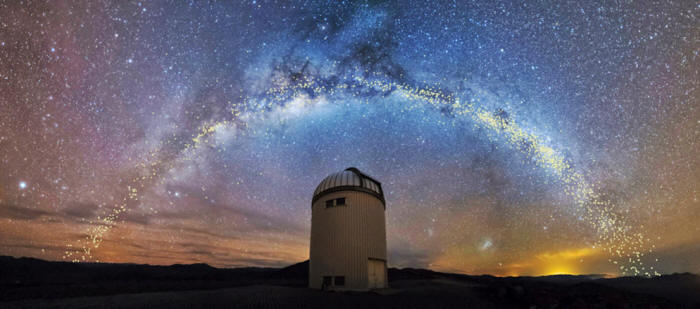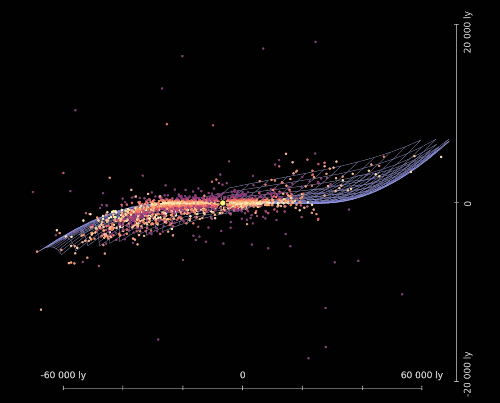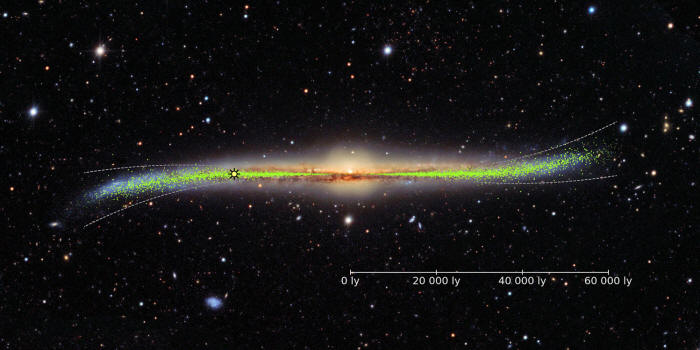|

by Devin Coldewey
August 01, 2019
from
TechCrunch Website

Image Credit: Skowron et al.
Six years of tracking a special class of star have yielded a new and
improved 3D model of our galaxy, based on direct observation rather
than theoretical frameworks.
And although no one ever
really thought the Milky Way was flat flat, the curves at its edges
have now been characterized in better detail than ever before.
Researchers at the University of Warsaw in Poland
took on this challenge some time
ago with the desire to observe the shape of the galaxy directly
rather than indirectly.
Although we have a good idea of the shape,
that idea is based on models that involve assumptions or
observations of other galaxies.
Imagine if you wanted to know the distance to the store, but the
only way you could tell was by looking out the window and observing
how long it took for someone to get there and back; by calculating
their average walking speed you can get a general idea.
Sure, it works to a point
- but wouldn't it be nice to just lean out the window and see
exactly how far it is?
The trouble in astronomy is it can be incredibly difficult to make
such direct observations with our present tools, so we rely on
indirect ones (like timing people above), something that can be
helpful and even accurate but is no substitute for the real thing.
Fortunately, the
researchers found that a certain type of star has special qualities
that allow us to tell exactly how far away it is.
"Cepheid variable stars" are young stellar bodies that burn far
brighter than our own sun, but also pulse in a very stable pattern.
Not only that, but the frequency of that pulsing corresponds
directly to how bright it gets - sort of like a strobe that, as you
turn the speed up or down, also makes it dimmer or brighter.
What this means is that if you know the frequency of the pulses, you
know objectively how much light the star puts out.
And by comparing that
absolute amount to the amount that reaches us, you can tell with
remarkable precision how far that light has had to travel.

Image Credit: Skowron et al.
"Distances to
Cepheids can be measured with an accuracy better than 5%," said
lead author Dorota Skowron in a video explaining the findings.
In comments to Space.com,
she
added:
"It is not some
statistical fact available only to a scientist's understanding.
It is apparent by eye."
Not only are these
beacons reliable, they're everywhere - the team located thousands of
Cepheid variable stars in the sky via the Optical Gravitational
Lensing Experiment, a project that tracks the brightness of billions
of stellar objects.
They carefully cataloged and observed these Cepheids (highlighted in
the top image) for years, and from repeated measurements emerged a
portrait of the galaxy - a curved portrait.

Image Credit: Skowron et al.
"Our map shows the
Milky Way disk is not flat. It is warped and twisted far away
from the galactic center," said co-author Przemek Mroz.
"This is the first
time we can use individual objects to show this in three
dimensions," some, he said, "as distant as the expected boundary
of the Galactic disk."
The galaxy curves "up" on
one side and "down" on the other, a bit like a hat with the brim
down in front and up in back.
What caused this
curvature is unknown, but of course there are many competing
theories. A close call with another galaxy? Dark matter? They're
working on it.
The researchers were also able to show by measuring the age of the
stars that they were created not regularly but in bunches - direct
evidence that star formation is not necessarily constant, but can
happen in bursts.
Their findings (A
Three-dimensional Map of the Milky Way using Classical Cepheid
Variable Stars) were published today in the journal
Science.
|




